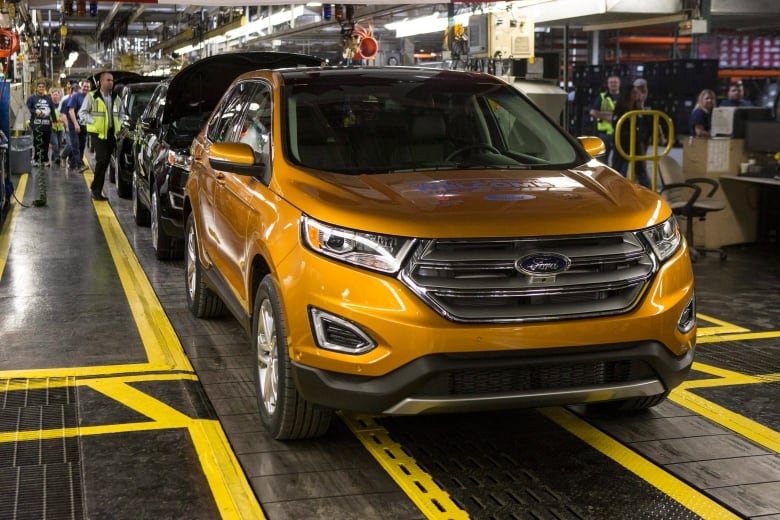A new U.S. government policy that offers tax credits for electric vehicles and batteries made by unionized labour in the United States puts Canada in a difficult position, according to both Canadian environmentalists and trade experts.
Part of the “Build Back Better” plan passed by Congress at the end of last week, it gets a thumbs up from many battling climate change on both sides of the border.
Offering an effective $12,500 US subsidy if American residents buy an electric vehicle rather than one with a traditional engine, the move is considered a positive step toward coaxing gas-powered vehicles — and their emissions — out of the market.
Like a high tariff
But there are cries from Canadian economic nationalists that if the subsidy only goes to American-made cars, as planned, it could simultaneously squeeze Canada out of the business of making EVs, resulting in an unfavourable effect on well-paying Canadian jobs.
It could also fracture North America’s deeply integrated automotive supply chain, with repercussions in the U.S. as well.
“Any cars made in Canada would not get the subsidy and would be a lot more expensive. In a way, it would be like imposing a high tariff,” explained Patrick Leblond, who teaches public and international affairs at the University of Ottawa.
It means that if U.S. residents — who make up the vast majority of North American vehicle buyers — were to buy an identical or similar car made in Canada, it would cost them thousands of dollars more.

Existing Canadian plants making internal combustion vehicles might not be affected, but that would change as automakers plan new factories. And the Buy American policy could influence those plans now.
“Obviously, the big carmakers would build their plants in the U.S. instead of in Canada,” said Leblond.
And just like when Donald Trump slapped tariffs on Canadian steel, aluminum and forest products, some say Canada must examine how it can make some sort of counter-threat, perhaps even offering up a list of products made in the U.S., but not in Canada, that would face tariffs here if the tax credit goes ahead.
“Sometimes, at least, the threat is a way to say, ‘Hey, let’s get our friends in the U.S. that depend on the Canadian economy to put pressure on Congress or the administration to make this thing go away,'” said Leblond.
‘Politically toxic’
As several of those I spoke to pointed out, offering a similar tax advantage for Canadian-made cars would not have the same effect, due to our unequal market clout. And putting tariffs on American-built EVs would simultaneously be bad for both climate change and Canadian auto-parts producers.
But one place Canada could take action would be on the production of key minerals needed to make EV batteries; Canadian mines, while currently undeveloped, could be a reliable and nearby non-Chinese source for the U.S. as demand for electrified transport ramps up.
Dan Ciuriak, a senior fellow at the Centre for International Governance Innovation in Waterloo, Ont., compares the battery-mineral situation to the time when Trump banned the export of masks to Canada — before realizing the fine pulp to make those masks actually came from Canada. That was the reason Trump backed off, he said.
But Ciuriak and others said there are also disadvantages to that kind of response. It could be “politically toxic,” Ciuriak said, for a bilateral relationship that is currently largely amicable.
Overcoming a protectionist agenda isn’t a problem easily solved.
“It is a big deal,” said Valerie Hughes, a Canadian lawyer with years of trade experience, including a decade at the World Trade Organization (WTO). While it depends on the final wording of the legislation, she said the EV tax credit is probably illegal under WTO rules and the Canada-U.S.-Mexico Agreement (CUSMA).
Hughes said she opposes the harsh trade retaliation that was seen in the Trump era.
“We did it once … because that was really the world we were living in,” said Hughes. “There was unilateral action that was contrary to the rules. The U.S. was doing it — and we just didn’t see a way out of it.”
But this time, said Hughes, there are much friendlier options, including vested Canadian parties reaching out to their U.S. counterparts at all levels — whether in government, industry or labour — to remind them that deeply integrated North American automobile production creates jobs and wealth on both sides of the border.

If necessary, Canada can always use the dispute-settling mechanisms of CUSMA, she said, calling them quite effective compared to the previous NAFTA dispute-settling process.
Mark Warner, a well-known Canadian trade lawyer, is skeptical of Ottawa’s proposition that Canada is being cheated by the plan. While that mentality may get people riled up, he said, the best way to work with the U.S. is calm negotiation.
Warner points out that the EV legislation is all about U.S. politics — an attempt to show that green investment will help create good American jobs. There is still time to negotiate, since the bill has yet to pass through the Senate. It will be five years before the Buy American portions of the law go into effect.
Climate change knows no borders
On the other hand, even a law coming in five years can affect business planning now. And once in effect, it will be harder to change.
In addition to convincing labour and business interests in the U.S. that continuing to work with Canada is in their own best interest, there is another potential set of allies, said Dale Beugin, with the Canadian Institute for Climate Choices.
U.S. climate scientists and activists, he said, know that greenhouse gases do not respect national boundaries.
“Climate change requires co-operation across countries, across borders — and you want to be enabling a low-carbon transition, not just in the U.S., but elsewhere as well,” said Beugin.
Squabbles over trade will just slow down the process.
To read the full commentary from CBC, please click here.
